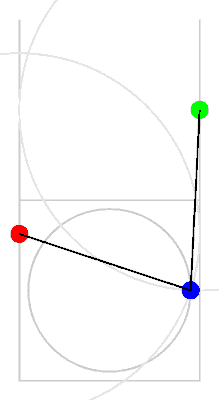First of all, if anyone is still swinging by this blog, yes, I’m still alive. While I haven’t exactly been prolific in my leisure activities, they haven’t stopped entirely. I worked on some simple embedded development for the hackaday.io 1K code challenge, which you can see on my hackaday.io page, and which hopefully I’ll write up here. I’ve got some additional projects in mind, so perhaps with a little extra effort on my part I’ll be getting back to more regular entries.
One of the things that has been kicking around in my head is to “make something that moves.” In particular, I’ve long been interested in gadgets like plotters, 3d printers, laser cutters and CNC machines. A few months ago on a whim, I ordered a CNC shield and Arduino so that I could begin to think about maybe creating a project which drives some steppers around to trace some pattern. I doubt that I possess the skills or know-how to do a good job of making a real CNC machine, but I kind of liked the idea of making a plotter. I started to work on the basic mechanical design of a simple 2D gantry. But frankly, I began to balk at the idea. You need two different sets of parallel ways, which seemed large and cumbersome, and each axis is different.
At the Maker Faire I had observed some simpler setups which generally go under the name of “Drawbots”. You can see an excellent write-up here on the “Death To Sharpie” page. I liked the idea a lot: it uses two steppers and the setups for each are symmetric. Each one winds and unwinds a chain, and the pen is suspended at the intersection of the two chains. In this incarnation, the pen doesn’t even have a separate control: it is simply drug around the poster board, leaving a trail wherever it goes. Pretty cool! I must admit though, I thought his software setup (laptop + Raspberry Pi + Arduino?) was a little complicated, and I’d probably enjoy working on the control software anyway.
But I was discussing this with my constant lunchtime companion Tom, discussing catenary curves and the like, and he basically said “why don’t you just use solid arms, making a 2D analog of the 3D delta robots you see in 3D printers?”
An awesome idea! One of the cool things about constructing a delta robot is that it consists of three essentially identical pillars. Yes, the three pillars all move slightly differently, but that is really a software issue, not a hardware one. A few moments of thought and I realized that you could make a pretty spiffy 2D version, and the math would actually be pretty easy.
So, in between tasks, I worked out the necessary quadratic equations, and created this gif that will demonstrate how the motion works.
The work space is the unit-size gray square at the bottom. It is bracketed by two rails, each of length two. Each has a carriage which runs along its side, and pins one end of a fixed arm (again, of unit length) which are held together in the center by a pin, which is where the pen will be. As you drive the red and green carriages back and forth, the intersection moves back and forth. It isn’t hard to see that the pen can reach any location in the unit square at the bottom.
It isn’t quite as compact as the typical drawbot, but I can’t help but think there are some serious mechanical advantages to setting up a bot this way. It should not be very hard to create an interpreter that could run on the Arduino that would take a small subset of G code and some basic scaling and rate information, and drive a pair of steppers to create this kind of a robot. I’ve never written code exactly like this before. It should be fun.
Stay tuned.
